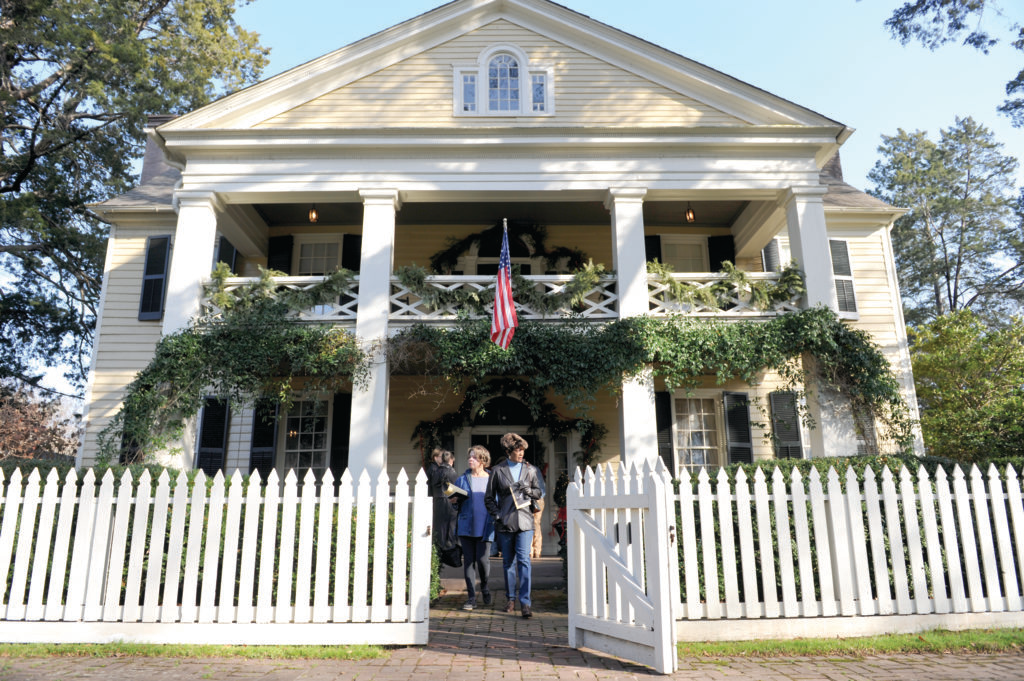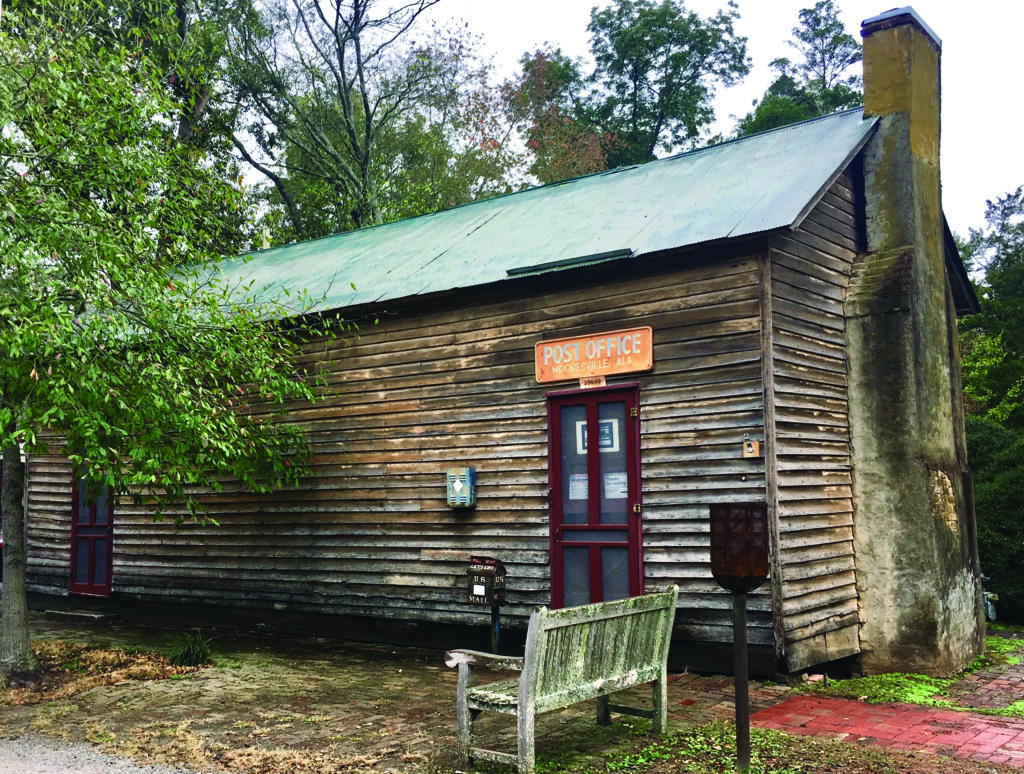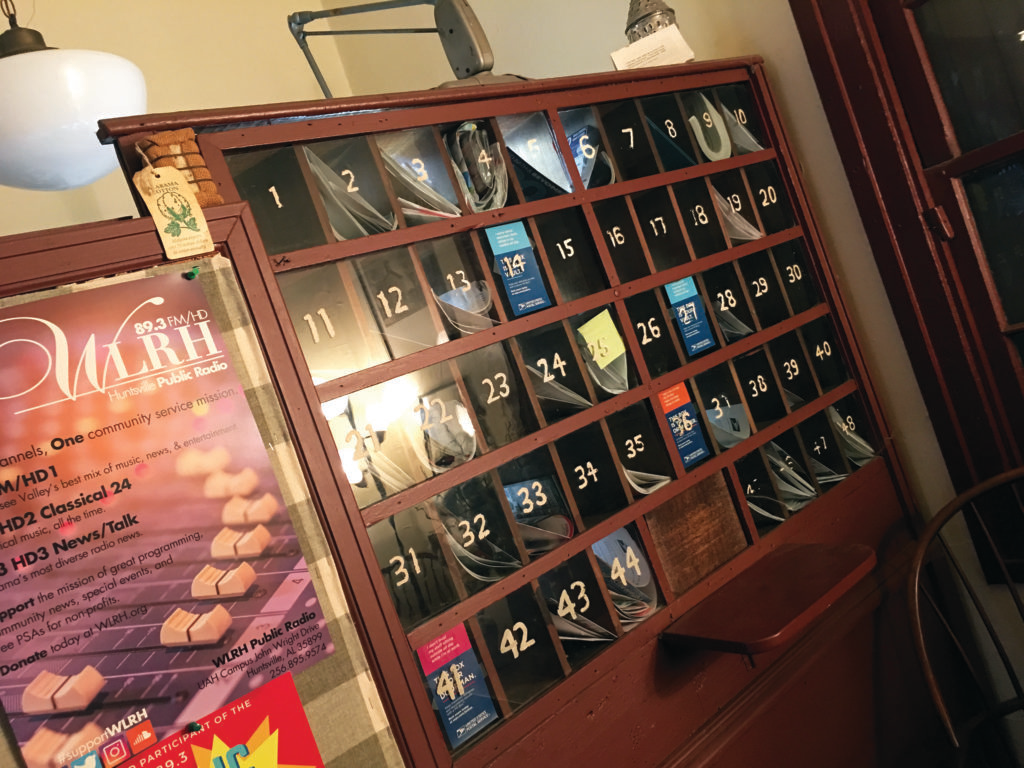Mooresville, pop. 59, has stories to tell
By Jennifer Crossley Howard

If Alabama had hamlets, Mooresville would be its poster child.
The town, which looks more like a village, sits tucked behind the Wheeler Wildlife Refuge, right off I-565, between Decatur and Huntsville. It is just out of earshot of traffic, and you know you’re there when you arrive at the split wood fence and block-letter sign.
“We wanted it to feel like you know you’re in Mooresville,” says former Mayor Margaret-Ann Crumlish of the fence. “It’s like we put a little hug around town.”
That embrace lingers with history, with which the town brims, as its entire .12 square miles is on the National Register of Historic Places. There’s the Brick Church, a Greek Revival haven for the betrothed, and the Dance Hall with its billowing white curtains. Homes retain the names of their owners, such as the Zeitler-Hill-McLain-Morin House, another Greek Revival ripe with pillars. Occasionally such houses go on the market, reminding you that this is no quaint film set. People live here. They come and go.
But mostly, they stay. Crumlish is the eighth generation of her family to live here.
“We’re like a big family,” she says. “We have to look out for each other because we’re so small.”
In pre-COVID days, neighbors congregated for front-porch margaritas and chili in the mayor’s kitchen. White picket fences outline yards, and old smokehouses sit behind many homes. A tennis court fills the backyard of another. Here, relics of the past mingle with the future.
There are no sidewalks; no need. Only two cars passed through in an hour’s time. A family with three children strolled by, bundled up on one winter day.
“We love seeing young ones,” says Shirley McCrary, tour guide and Crumlish’s mother. “The new blood that can help us maintain the town.”
Retirees, lawyers, an architect and numerous employees of Redstone Arsenal make up some of the population that now stands at less than 60.
One would assume that heavy traffic would be last on a list of pet peeves of living in a town smaller than many college lecture halls. Commuting is a reality for residents of Mooresville, which lacks schools and the usual number of churches that line many a road in Alabama, so residents travel to worship, learn and shop.
“You learn to manage your time in the car, and it works,” Crumlish says.
But they need not stray too far from their village for a new bike or for homespun skincare. Southern Carnage, the bike shop, also repairs the wheels of cyclists who habitually race laps around Mooresville’s blocks.
The town is older than the state of Alabama by a year — a point of pride for its citizens. That history lends the town such distinctions as having the oldest-continuously operated post office in the state. Residents must walk into the room-sized log cabin to pick up their mail every Saturday. Considering country-wide mail carrier shortages, they declined to add anytime walk-in hours.
“We thought if we agreed, that it might shut us down,” Crumlish says.
The post office almost closed in the 1980s, but U.S. Sen. Howell Heflin intervened to keep it open. The humble building has served as a gathering place since its doors opened, and remains so.
Like Athens and surrounding areas in north Alabama, farming runs deep in the roots of Mooresville’s heritage. Current businesses such as 1818 Farms honor that past with herds of sheep scampering across a field. Wooden fences and low-hanging magnolia trees frame the scene. 1818 Farms operates a farm, flower truck and sells bath and beauty products made on site. It also serves as an event venue and breeds sheep. (See related story, Page 14.)
Photos by Lenore Vickrey
Mooresville’s family atmosphere and deep history set it apart and seemed a natural fit when 1818 Farms owner Natasha McCrary decided to launch her business there almost 10 years ago.
“The town is the perfect location for a business whose mission is preserving history and honoring tradition by working a sustainable farm, producing handmade products and educating the public on the value of self-sufficiency, craftsmanship and a strong sense of community,” she says.
In 2019, Amazon honored McCrary, a sixth-generation Mooresvillian, as a Small Business Spotlight winner in the woman-owned small business category. Though the business side of 1818 Farms takes place in Huntsville, its soul and goods are grounded in Mooresville.
McCrary raises Babydoll Southdown sheep, a Nubian goat, hens and more on her farm. Cats and Great Pyrenees dogs keep everyone in line. In a field adjacent to the animals, zinnias, daisies and sweet peas flourish in the spring. A flower truck travels around Athens, Madison, Decatur and Huntsville, allowing customers to personalize bouquets.
Loyal social media followers amount to almost 30,000 on Instagram alone.
The town has paused its annual Christmas celebration for now — Crumlish says the nostalgic weekend event requires too much work and money for the crowd of a few hundred it drew in later years. But the town plans a new tradition this winter. Holiday Sounds, a Native American flute-centric group from Oklahoma, will center on the square to play the second weekend of December. Tickets will be available on mooresvilleal.com.
The long-term plan is for Mooresville to become part of something bigger while retaining its historical authenticity. Over the next 10 years, the Singing River Trail will link Madison, Belle Mina, Mooresville, Decatur and Huntsville in honoring the state’s Native American heritage while providing cyclists and runners a paved path to enjoy nature, says current Mayor Nikki Sprader. Also on the horizon is Mooresville’s inaugural arts festival to take place next May.
Throughout its more than 200-year history, the languid pace of Mooresville continues to quietly soldier on through progress and the wear and tear of time.
At the top of the Brick Church’s steeple, a wooden hand points heavenward. The style was adopted from a church a townsperson spotted in Port Gibson, Mississippi. The Brick Church fell in the 1920s and has since been restored. It retains its hard-won scars acquired from years of survival. It signals a hope resonant in this little town that could, did and will.







